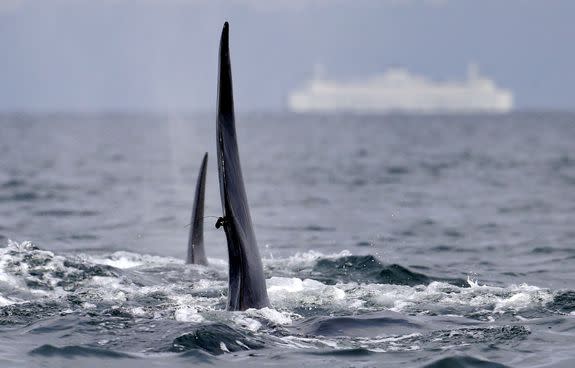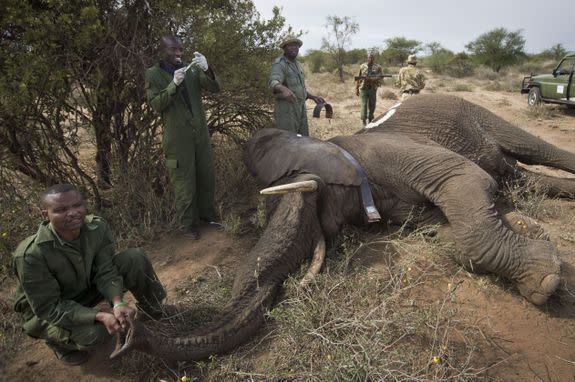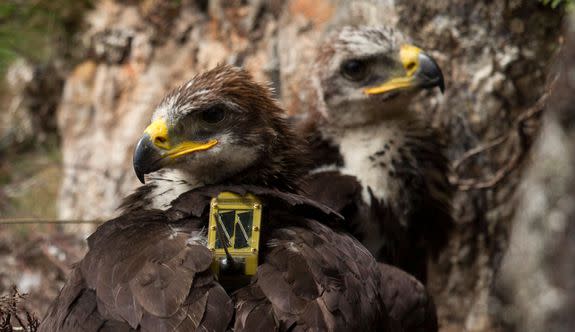It's time to start thinking about cybersecurity for sharks. Yes, the fish.

In 2015, three scientists sent an anguished note to the journal Conservation Letters.
Anti-shark paranoia was settling over Western Australia, and the state government had issued a controversial kill order. Scientists said the cull's safety benefits were unproven and could potentially hurt recovering populations of white sharks. Worse, they claimed at least one shark marked for death was located only because it had been acoustically tagged by researchers.
The policy was eventually abandoned, but it highlighted an important point: Fitting animals with transmitters so scientists can track their every movement may also leave them vulnerable. Technology that's ostensibly there to help these species thrive can actually be used against them.
SEE ALSO: What would animals say if tech let them talk? Nothing good, probably.
Steven Cooke, director of the Institute of Environmental Science at Canada's Carleton University, wants researchers to start thinking about these unintended consequences.
The lead author of a recent paper about the potential risks of animal tracking in Conservation Biology, he admitted there's been little data collected on the topic. Nevertheless, the research is a "call to action," Cooke said.
Tracking technology has been good for science, but there are risks, too. Whether it's the government demanding the whereabouts of predators or poachers looking to hunt endangered species, scientists must ensure animal tracking data doesn't fall into the wrong hands.

Image: Uncredited/AP/REX/Shutterstock
Getting the technology in order
Tracking technology offers a wealth of information about an animal's habits and movements — datasets that might be valuable to poachers as well as scientists.
Advanced Telemetry Systems (ATS) in Minnesota is one of several global companies that makes animal tracking tags.
"We put transmitters on bees, crayfish, just about any kind of fish out there," said Joseph Allen, a sales manager at ATS. "Any kind of bird besides sea birds, large wildlife — anything."
At ATS, there are two main tracker types, he explained: VHF tracking and GPS tacking.
The first allows researchers to use a radio scanner to hear and locate an animal that's been fitted with a tag. The second employs satellite tracking to locate animals wearing GPS tags or collars. Typically, this GPS information is stored on a secure website.

Image: Ben Curtis/AP/REX/Shutterstock
While rare, both forms of tracking may allow animals to be hunted down by people with bad intentions.
"[VHF tracking] would be relatively easy for anybody who has a radio receiver to try and find an animal that way," Allen admitted. "It's not very difficult."
It's so easy, in fact, that Parks Canada banned the use of radio receivers in a number of mountain parks in 2016, CBC reported, after photographers were apparently using them to track down collared elk and bears.
While the GPS information is harder to access, it's not impossible. In one infamous 2013 case, hackers reportedly tried to access the email of one Indian researcher in order to pinpoint the location of an endangered Bengal tiger wearing a GPS collar.
Still, Allen said the hacking of animal tracking data was not something his team was too concerned about. ATS has not been fielding concerned calls from customers about intercepted radio signals, either.
"I'm sure it's probably happened, but we don't know of any particular instances that we've been informed about," he said.
Protecting the data
Once an animal's location has been collected from the field, it's only passed the first safety hurdle.
Just who can see an animal's tracking data is something Rob Harcourt thinks about. He leads the Integrated Marine Observing System's (IMOS) animal tracking facility in Australia. A government-funded group, IMOS assists with "the tagging of any species people want to tag."
He helped author that 2015 letter about the fate of tagged sharks in Western Australia, and at IMOS, the incident prompted the group to take new steps to protect shark data.
Typically, IMOS data is publicly available, but the group recently introduced a "protected" category that keeps that location information hidden from all but a few select people.

Image: Getty Images
"It's in the database, but no one can see it apart from the owner of the tags, and that is to protect sensitive species which might be under threat," Harcourt explained. "It's only been enacted once, and that was for the white shark."
"There are certain circumstances where not everybody behaves responsibly," he added. "So we were trying to protect animals from unethical behavior by particular groups."
Ultimately, Cooke wants researchers to start thinking about things like encryption and other forms of data security: "We often demand data be shared and details of study sites to be revealed — this needs to be balanced with risk."
His message is that tagging is a vital research tool for scientists. Cooke just aims to make it safe for animals, too.

 Yahoo News
Yahoo News 